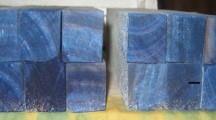Abstract
Two proprietary biocides were compounded and extruded at three concentrations, respectively, into high density polyethylene-maple wood flour lumber (HDPE-MWL) and evaluated for their efficacy to control fungal colonization and discoloration using the ASTM Standard G 21-96. Although the silver biocide used in this study did not control fungal colonization and discoloration of HDPE-MWL, statistically significant difference was observed between the highest silver biocide concentration and those of the two lower silver biocide concentrations. The latter exhibited no significant difference with the controls. In contrast, the three levels of zinc biocides showed significant difference from each other with respect to their efficacy against fungal colonization and discoloration of HDPE-MWL. Overall, only the zinc biocide was efficacious against fungal colonization and discoloration. The biocide containing zinc as an active biocidal agent was most efficacious at 1% (by weight) concentration.
Zusammenfassung
Zwei praxisübliche Holzschutzmittel wurden jeweils in drei Konzentrationen in einen WPC-Holzwerkstoff eingebracht und hinsichtlich ihrer Wirksamkeit gegenüber Pilzbefall und Verfärbung nach dem ASTM Standard G 21-96 untersucht. Das in dieser Studie verwendete Biozid auf Silberbasis erwies sich insgesamt als nicht wirksam gegenüber Pilzbefall und Verfärbung von HDPE-MWL. Jedoch wurde ein statistisch signifikanter Unterschied zwischen dem Biozid mit der höchsten Konzentration und den beiden niedrigeren Konzentrationen festgestellt. Bei letzteren ergab sich kein signifikanter Unterschied zu den Kontrollproben. Im Gegensatz dazu unterschieden sich die drei Biozide mit den Zinkkonzentrationen hinsichtlich ihrer Wirksamkeit gegen Pilzbefall und Verfärbung von HDPE-MWL signifikant voneinander. Somit ist nur das Zinkbiozid gegen Pilzbefall und Verfärbung wirksam. Am wirksamsten war das Holzschutzmittel mit Zink in einer Konzentration von 1%.
Similar content being viewed by others
References
ASTM Standard G 21-96 (2002) Annual book of standards. Standard practice for determining resistance of synthetic polymeric materials to fungi
Dawson-Andoh B, Matuana L, Harrison J (2005) Susceptibility of high-density polyethylene-wood flour composite lumber to biodeterioration. J Inst Wood Sci 17(2), issue 98.114-119
Dawson-Andoh B, Matuana L, Harrison J (2004) Mold susceptibility of Rigid PVC/Wood flour composites. J Vinyl Addit Technol 10(4):178–186
SPSS statistical analytical software version 13 (2004) Chicago, IL
Author information
Authors and Affiliations
Corresponding author
Rights and permissions
About this article
Cite this article
Dawson-Andoh, B., Matuana, L. High density polyethylene-wood flour composite lumber: efficacy of two proprietary biocides in the control of fungal colonization and discoloration . Holz Roh Werkst 65, 331–334 (2007). https://doi.org/10.1007/s00107-007-0182-8
Published:
Issue Date:
DOI: https://doi.org/10.1007/s00107-007-0182-8




